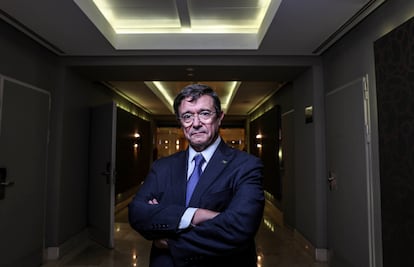Andrés Cervantes, oncologist: ‘Innovative cancer drugs have similar costs, regardless of their benefit’
The president of the European Society of Medical Oncology reviews the latest advances against cancer presented at its annual congress in Madrid

Over the last four days, around 35,000 oncologists from all over the world have gathered in Madrid to learn about the latest advances in cancer treatment. The European Society for Medical Oncology (ESMO) held its annual congress, in which progress has been announced that shows some of the most fruitful treatments in the fight against these diseases. Andrés Cervantes, head of the Medical Oncology service at the University Clinical Hospital of Valencia and president of ESMO, mentions “medicines that address a molecular alteration called RET, which occurs in around 2% of patients with lung cancer and in the majority of cases of one type of thyroid cancer.” The oncologist goes on to explain that, although these diseases are in two organs that have nothing to do with each other, because they have this molecular abnormality, “targeted therapies have been developed that double survival rates in thyroid cancer compared to other more targeted conventional therapies, and in lung cancer they are far superior to chemotherapy.”
These types of therapy that are designed to fight molecular alterations, which require access to biomarkers that are not always available, are one of the latest trends in oncology. Another is conjugated drugs, which combine a targetable antibody linked to a chemotherapy agent and allow the release of the effective, but very toxic, drug in the place where it does the most damage to the tumor and the least harm to the person. Combined with immunotherapy, this kind of medication has managed to double the chances of survival, from 17 months to more than 30 in bladder cancer. “That does not strictly mean that patients will live twice as long. It also means that there are many who are not going to relapse and that many can be cured, because more follow-up must be done. It is a radical change in the disease,” Cervantes explains. The oncologist also highlights the congress presentations that show that oncology is experiencing a golden era and the large number of innovations and adaptations of old ideas to new problems to provide new solutions.
Question. Can this accelerated innovation make it more difficult for the best treatments to reach everyone? Is it possible to combine innovation and equity?
Answer. Personalized medicine has two effects. You treat those you have to treat and you don’t treat those you don’t have to treat. From a financial point of view, before, limited improvements were made to the general population and the treatment was applied to all patients. Thus, personalized drugs would fail in the general population. However, they are having success in patients with positive biomarkers. Biomarkers help us to choose [the right drugs] so that treatment is more efficient. This, of course, can limit access. ESMO has reviewed the situation in 45 countries and the availability of massive sequencing techniques for the detection of molecular anomalies to which treatments can be directed is far from being universally accessible; it is a problem that we have to analyze. We have to prioritize innovations with the greatest benefit. At ESMO we have created an instrument to calculate a benefit score every time the European Medicines Agency approves a drug, and we are in negotiations with the WHO so that all those with the highest score are declared essential medicines and the access to the patient.
Q. According to the scale you mentioned, are there drugs that do not provide what is paid for them?
A. One of the things that ESMO detected when it made this scale is that all the medicines that came from innovation had similar costs, independent of the value, of the benefit for society, improving survival, reducing toxic effects, and improving people’s quality of life. I believe that this has to be considered when developing medications. It wouldn’t be a problem to raise the bar either. Because when there are no medications for a disease, anything that has a small effect generates hope, but it may not generate the value that one would expect. Perhaps the bar needs to be raised so that those that pass deliver a greater benefit.
Q. Another topic that has been discussed at the congress and that has been studied for some time is the effect of environmental pollution on cancer. Is it possible to balance the great deal of effort put into the search for treatments with that which is allocated to study and prevention?
A. The disease is a failure of prevention, which will take on more importance. At last year’s ESMO congress, it was commented that air pollution influences the promotion of lung cancer. This year, we have seen that exposure to compounds in jobs typically held by women can increase the risk of cancer, and it appears to be linked to contact and inhalation of microplastics. This may be one of the preventable causes of cancer. More studies are needed to gain more knowledge and to take measures to protect the public. At first glance, creating smoke or traffic-free spaces seems like a rational measure.

Q. On the issue of prevention, how far can the state go? We know that smoking and drinking increase the risk of developing cancer. Should drastic measures be taken that force us to do things that reduce health risks, similar to what was done in the pandemic?
A. Everything has psychological and behavioral aspects. We must have a good understanding of how the habit of smoking is acquired, what the factors that intervene in the development of obesity are, why people do not do physical activity, and so on. We have to understand these factors, because this is not a problem of giving orders. Each individual has their freedom, but I believe that if this were taught and encouraged, it would have an effect on public health.
Q. Many of the advances in cancer treatments are financed by the pharmaceutical industry, which, in addition to seeking benefits for patients, has to answer to its shareholders. What can academic research contribute in this environment?
A. It has a fundamental part in innovation and scientific development. I believe that our country is a model in the development of CAR-T [a type of treatment against blood tumors that in its commercial version can cost €300,000 ($317,325) and costs €50,000 ($52,887) in its academic version] that compete in quality with commercial models. That has a very positive impact. There are also academic studies that raise questions that may not be relevant to the industry, but that change how we treat a disease. Presented here is a cervical cancer study showing that adding chemotherapy prior to chemoradiotherapy improves the survival and curability of patients with locally advanced cervical cancer. This trial has been developed by academic institutions in the United Kingdom, and hospitals in Mexico have participated — the disease is very prevalent in Latin America — and it is a study in which there is no industry involvement. The drugs that were used lost their patent more than 10 years ago, yet this effort has had a positive impact on society.
Q. With the enormous amount of data required to diagnose cancer today, the subtypes of the disease, the markers for certain genetic alterations, the characteristics of the patients, etc. What role can artificial intelligence play?
A. The opportunity to teach a machine to interpret the appearance of a cell or tumor, the models to analyze CT images, or the pathologies of biopsies and then correlate them with molecular anomalies, is of great interest and could be used as a tool in facilitating equity in access to molecular techniques. I think that artificial intelligence is going to help us be better doctors, because we will be able to dedicate ourselves more to the interaction with the patient and manage the complexity of today’s molecular diagnostic techniques more efficiently.
Sign up for our weekly newsletter to get more English-language news coverage from EL PAÍS USA Edition
Tu suscripción se está usando en otro dispositivo
¿Quieres añadir otro usuario a tu suscripción?
Si continúas leyendo en este dispositivo, no se podrá leer en el otro.
FlechaTu suscripción se está usando en otro dispositivo y solo puedes acceder a EL PAÍS desde un dispositivo a la vez.
Si quieres compartir tu cuenta, cambia tu suscripción a la modalidad Premium, así podrás añadir otro usuario. Cada uno accederá con su propia cuenta de email, lo que os permitirá personalizar vuestra experiencia en EL PAÍS.
¿Tienes una suscripción de empresa? Accede aquí para contratar más cuentas.
En el caso de no saber quién está usando tu cuenta, te recomendamos cambiar tu contraseña aquí.
Si decides continuar compartiendo tu cuenta, este mensaje se mostrará en tu dispositivo y en el de la otra persona que está usando tu cuenta de forma indefinida, afectando a tu experiencia de lectura. Puedes consultar aquí los términos y condiciones de la suscripción digital.
More information
Archived In
Últimas noticias
Welcome to the post-religion era: The idea of Christianity as the absolute truth has become obsolete
‘I thought you would like it’: The risky sexual practice popularized by TV shows and TikTok
The digitalization of tourism: ‘They promise experiences and gave us the worst possible one’
Mexican peso defies uncertainty with forecasts of a new period of stability in 2026
Most viewed
- Sinaloa Cartel war is taking its toll on Los Chapitos
- Oona Chaplin: ‘I told James Cameron that I was living in a treehouse and starting a permaculture project with a friend’
- Reinhard Genzel, Nobel laureate in physics: ‘One-minute videos will never give you the truth’
- Why the price of coffee has skyrocketed: from Brazilian plantations to specialty coffee houses
- Silver prices are going crazy: This is what’s fueling the rally











































